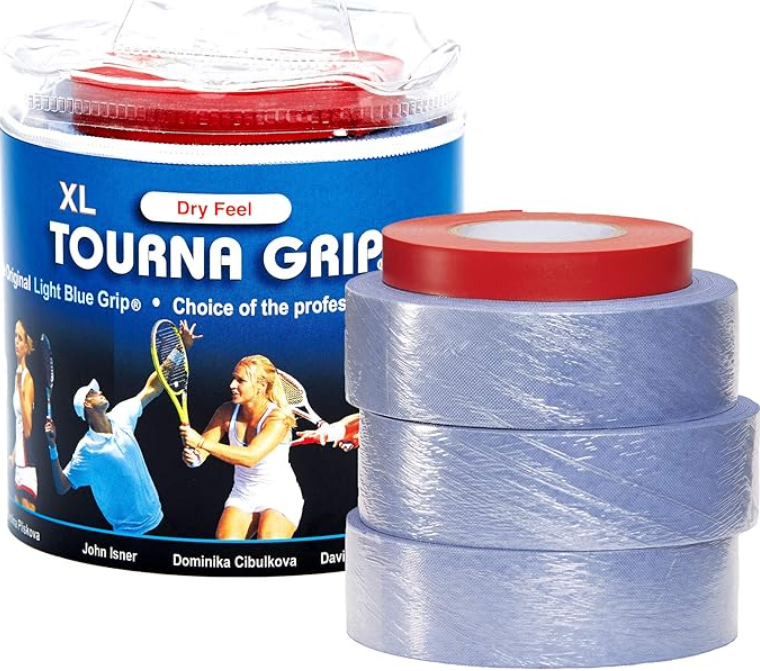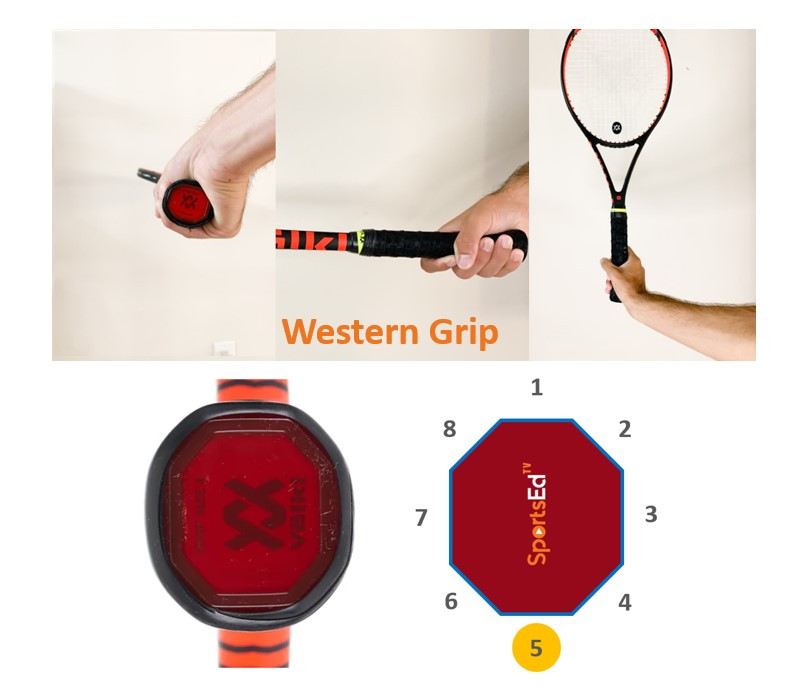Tennis
Welcome and thanks for visiting...

The Different Types of Tennis Grips and How to Choose the Right One for your forehand

The tennis grip you choose can have a significant impact on your performance on the court. With so many different tennis grips available, knowing which one is right for you can be challenging. In this article, we'll explore the various types of tennis grips and provide tips to help you choose the best one for your game.
Why use overgrip tape in tennis?
Let's quickly mention overgrip tapes before entering the specific tennis grips. Ovegrip tape for tennis is a game-changer, providing enhanced comfort and improved grip on the racquet handle. It cushions against impacts, reducing the risk of hand blisters during prolonged play and ensuring a steady, secure grip even in sweaty conditions. This leads to better control and precision in every shot. Moreover, its variety in colors and patterns adds a personal touch to your racquet while protecting the original grip. In short, overgrip tape is an indispensable tool for any tennis player looking to elevate their game.
The Different Types of Tennis Grips
There are several different types of tennis grips, each with its own advantages and disadvantages. The most common grips include the Eastern forehand grip, the Western forehand grip, the Continental grip, and the Semi-Western forehand grip. Each grip affects the angle of the racket face and the amount of spin you can put on the ball. It's important to experiment with different grips to find the most comfortable and effective for your playing style.
The Eastern Forehand Grip
The Eastern Forehand Grip is a popular and beginner-friendly way to hold a tennis racket when executing forehand shots. This grip style offers a balanced mix of power, control, and moderate topspin, making it suitable for players learning the fundamentals of the game.
To form the Eastern Forehand Grip, follow these simple steps:
- For right-handed players, locate the third bevel (flat edge) on the racket handle. If you're left-handed, find the seventh bevel.
- Place the base knuckle of your index finger against the selected bevel.
- Wrap the rest of your fingers comfortably around the racket handle, ensuring your fingers are slightly spread apart for a secure grip.
- Rest your thumb against the back of the handle for added support.
Holding the racket with an Eastern Forehand Grip should feel like you are shaking hands with the racket, making it a natural and comfortable grip for most beginners.
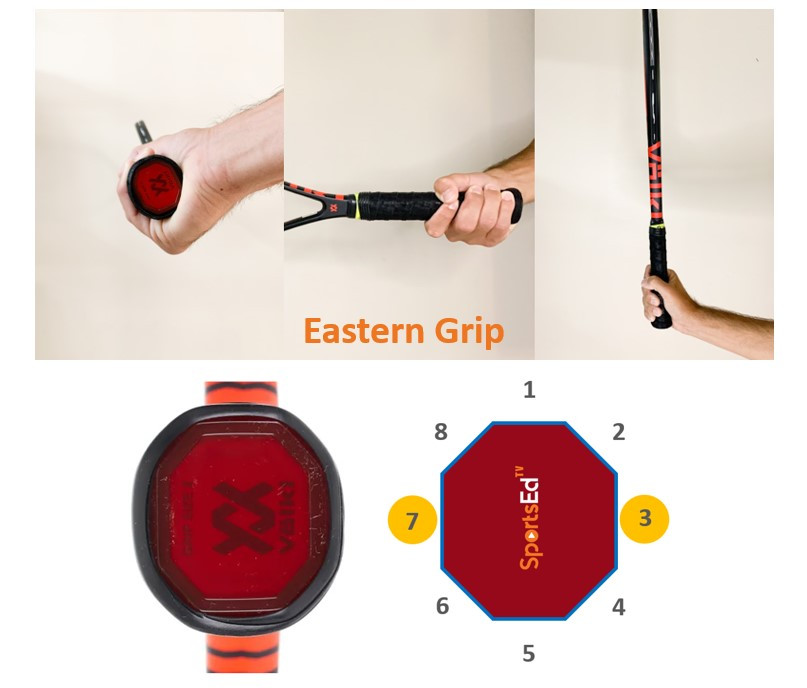
The Semi-Western Forehand Grip
The Semi-Western Forehand Grip is a very popular tennis grip. It allows players to generate a blend of power, control, and topspin on their forehand shots, making it a suitable choice for various playing styles and levels, including beginners.
To form the Semi-Western Forehand Grip, follow these clear and beginner-friendly steps:
- For right-handed players, identify the fourth bevel (flat edge) on the racket handle. If you're left-handed, locate the sixth bevel.
- Position the base knuckle of your index finger against the selected bevel.
- Comfortably wrap the rest of your fingers around the racket handle, keeping your fingers slightly spread apart for a secure and firm grip.
- Rest your thumb against the back of the handle to provide additional support.
When using the Semi-Western Forehand Grip, the racket will feel slightly tilted downward in your hand (the face will be naturally slightly closed), giving you an optimal angle to generate topspin at contact on your shots.
The Semi-Western Forehand Grip offers a balance between the moderate topspin of the Eastern grip and, even more, the heavy topspin of the full Western grip, allowing players to hit aggressive, penetrating topspin shots at various heights while maintaining a high margin for error. The grip is effective in handling a variety of ball heights and bounces, making it a versatile choice for beginners and advanced players alike.
While the Semi-Western Forehand Grip may require some practice for transitioning to volleys or slice shots, its versatility and adaptability make it an excellent grip to learn and incorporate into your game as you progress in your tennis journey.
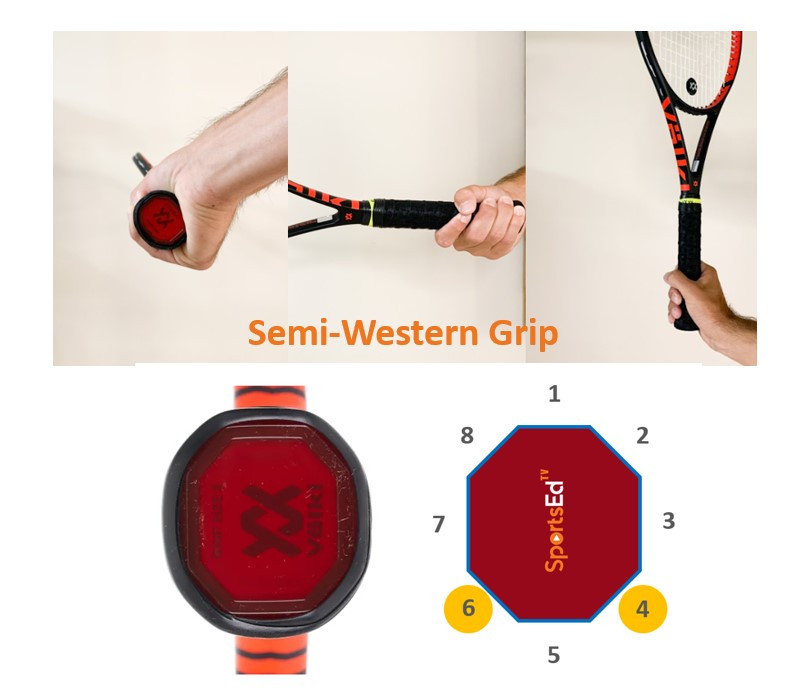
The Western Forehand Grip
The Western Forehand Grip is a distinctive and specialized tennis grip that keeps your wrist loose and is primarily used for generating powerful forehand shots with heavy topspins. This grip is popular among advanced players and professionals but may be less intuitive for beginners. However, understanding the grip and its benefits can be helpful as you progress in your tennis journey.
To form the Western Forehand Grip, follow these straightforward steps:
- For right-handed players, find the fifth bevel (flat edge) on the racket handle. If you're left-handed, locate the first bevel.
- Place the base knuckle of your index finger against the chosen bevel.
- Gently wrap the rest of your fingers around the racket handle, maintaining a slight separation between your fingers for a stable grip.
- Rest your thumb against the back of the handle to offer added support.
When using the Western Forehand Grip, it may feel like you are holding the racket with your palm facing upward, giving you a unique grip position compared to other styles.
The Western Forehand Grip allows players to generate significant topspin on their shots, resulting in a high-arching ball trajectory that clears the net and drops quickly into the court. This grip is particularly useful for aggressive baseline play and handling high-bouncing balls. However, it may be more challenging to hit flatter shots or low-bouncing balls, and transitioning to volleys or slice shots can be less intuitive.
While the Western Forehand Grip may not be the most beginner-friendly option, understanding its characteristics and benefits can be valuable for players looking to develop their game and explore various grip styles as they progress. Some coaches will change players from the full Western to a Semi-Western grip.
The Continental Forehand Grip
The Continental Forehand Grip, often referred to as the "chopper grip" due to its similarity to holding an axe, is a versatile tennis grip that can be used for a variety of shots. Although it's not as popular for forehands in modern tennis as it once was, it remains an essential grip for beginners to learn due to its adaptability.
To form the Continental Forehand Grip, follow these easy-to-understand steps:
- For right-handed players, identify the second bevel (flat edge) on the racket handle. If you're left-handed, locate the eighth bevel.
- Position the base knuckle of your index finger against the selected bevel.
- Comfortably wrap the rest of your fingers around the racket handle, with your fingers slightly spread apart to ensure a firm grip.
- Place your thumb against the back of the handle for additional support.
When using the Continental Forehand Grip, the racket should feel like an extension of your hand, as if holding a hammer. This provides a comfortable and natural grip for most beginners.
Although the Continental Forehand Grip may not generate as much topspin or power as the Eastern, Western, or Semi-Western grips, its versatility makes it invaluable for learning various shots, such as volleys, serves, overheads, and slices. As beginners become more familiar with the game and develop their skills, they may transition to other grip styles for specific shots while retaining the Continental Grip for its multi-purpose functionality.
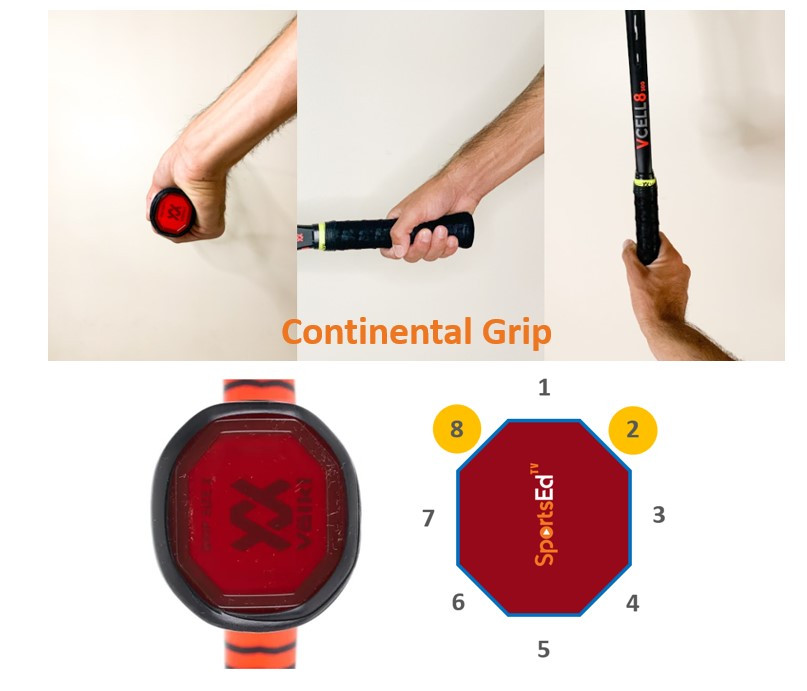
Understanding the various forehand grip styles is crucial for players seeking to elevate their tennis game and develop a personalized, effective approach on the court. Each option offers unique advantages and challenges, from the versatile Continental grip to the topspin-oriented Western and Semi-Western grips. Beginners should experiment with these different grips, finding the one that best aligns with their playing style and comfort level. As players progress and refine their skills, they may choose to adopt a combination of these grips to maximize their shot-making abilities and adaptability in various match situations. Ultimately, mastering the art of the forehand grip is a vital step on the path to becoming a well-rounded and formidable tennis player.


